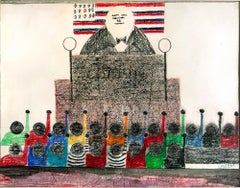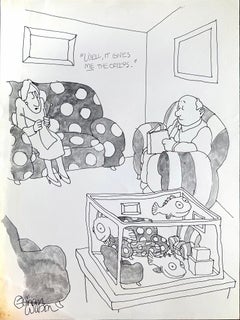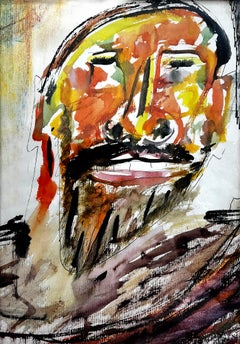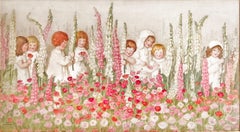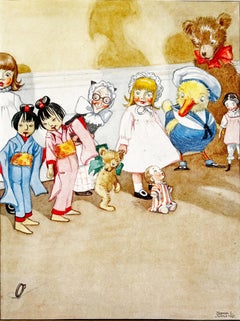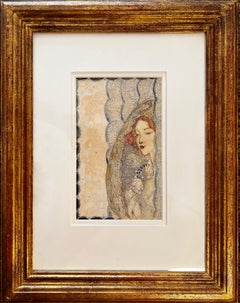Robert Funk Fine Art Drawings and Watercolor Paintings
1970s American Modern Figurative Drawings and Watercolors
Watercolor, Pen, Pencil, Paper
1990s American Modern Figurative Drawings and Watercolors
Paper, Ink, Watercolor, Pen
1960s Expressionist Portrait Drawings and Watercolors
Paper, Watercolor, Pen
Early 1900s Pre-Raphaelite Figurative Drawings and Watercolors
Watercolor, Paper, Pencil
1920s Victorian Figurative Drawings and Watercolors
Watercolor, Gouache
Early 1900s Art Nouveau Figurative Drawings and Watercolors
Paper, Ink, Watercolor
Early 1900s Art Nouveau Figurative Drawings and Watercolors
Ink, Watercolor, Pencil
Early 1900s Romantic Figurative Drawings and Watercolors
Paper, Pen, Ink
1960s Surrealist Figurative Drawings and Watercolors
Mixed Media, Gouache, Board, Illustration Board
1890s Pre-Raphaelite Figurative Drawings and Watercolors
Paper, Ink, Pen
1960s American Realist Landscape Drawings and Watercolors
Ink, Gouache, Illustration Board
1950s Modern Portrait Drawings and Watercolors
Casein, Board, Pen
1980s American Modern Animal Drawings and Watercolors
Gouache
1920s American Realist Figurative Drawings and Watercolors
India Ink, Pencil
1940s Expressionist Figurative Drawings and Watercolors
Paper, Ink, Watercolor, Pen
1930s American Realist Landscape Drawings and Watercolors
Paper, Charcoal
1910s Victorian Portrait Drawings and Watercolors
Ink, Illustration Board, Pen
1930s Art Deco Animal Drawings and Watercolors
Crayon, Paper
1910s Academic Figurative Drawings and Watercolors
Paper, Chalk, Charcoal
1890s Academic Figurative Drawings and Watercolors
Paper, Watercolor
1970s Modern Figurative Drawings and Watercolors
Paper, Mixed Media, Watercolor
1950s American Realist Figurative Drawings and Watercolors
Ink, Watercolor
1920s Figurative Drawings and Watercolors
Paper, Ink, Gouache
1920s Art Deco Figurative Drawings and Watercolors
Paper, Ink
1950s Surrealist Landscape Drawings and Watercolors
Watercolor, Rag Paper
1920s Post-Impressionist Figurative Drawings and Watercolors
Ink, Watercolor
1930s Academic Figurative Drawings and Watercolors
Ink, Watercolor, Board
1930s Mixed Media
Paper, Watercolor, Pencil
1970s Modern Figurative Drawings and Watercolors
Watercolor
1940s Contemporary Landscape Drawings and Watercolors
Watercolor, Pencil
1960s American Realist Figurative Drawings and Watercolors
Watercolor, Pencil
1950s Surrealist Nude Drawings and Watercolors
Paper, Pencil
1960s Contemporary Figurative Drawings and Watercolors
Watercolor, Permanent Marker, Carbon Pencil
Early 1900s Art Nouveau Figurative Drawings and Watercolors
Ink, Illustration Board, Pen
1940s Feminist Figurative Drawings and Watercolors
Gouache, Board
1930s Art Nouveau Figurative Drawings and Watercolors
Ink, Pencil
1920s Vienna Secession Figurative Drawings and Watercolors
Ink, Watercolor, Pigment
1980s Surrealist Figurative Drawings and Watercolors
Paper, Ink, Watercolor
1920s Art Deco Figurative Drawings and Watercolors
Gold Leaf
1950s English School Figurative Drawings and Watercolors
Ink, Pen
1920s Art Nouveau Figurative Drawings and Watercolors
Ink, Pen
1910s Art Nouveau Figurative Drawings and Watercolors
Watercolor, Gouache, Pencil
1920s American Modern Animal Drawings and Watercolors
Ink, Pen
1930s Art Deco Landscape Drawings and Watercolors
Paper, Ink
1960s Abstract Expressionist Figurative Drawings and Watercolors
Paper, Charcoal
1940s Academic Figurative Drawings and Watercolors
Paper, Graphite
Early 1900s Art Nouveau Figurative Drawings and Watercolors
Paper, Ink, Watercolor
1930s Art Deco Landscape Drawings and Watercolors
Ink, Gouache, Pen
Early 20th Century American Realist Landscape Drawings and Watercolors
Watercolor
1950s Feminist Figurative Drawings and Watercolors
Watercolor, Pencil
1910s Art Nouveau Figurative Drawings and Watercolors
Watercolor
1920s Art Nouveau Figurative Drawings and Watercolors
Pencil, Woodcut
1920s Conceptual Figurative Drawings and Watercolors
Ink, Color Pencil, Graphite
1940s Art Deco Figurative Drawings and Watercolors
Watercolor, Gouache
1920s Symbolist Landscape Drawings and Watercolors
Ink, Watercolor
1930s American Modern Figurative Drawings and Watercolors
Paper, Graphite
1950s Modern Figurative Drawings and Watercolors
Watercolor, Pencil
1940s Modern Figurative Drawings and Watercolors
Watercolor, Ink
1990s Modern Figurative Drawings and Watercolors
Ink, Watercolor
1920s Art Deco Figurative Drawings and Watercolors
Watercolor, Pencil
